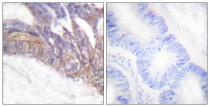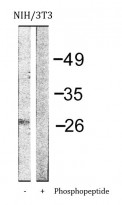ARG66637
anti-LAT phospho (Tyr200) antibody
anti-LAT phospho (Tyr200) antibody for IHC-Formalin-fixed paraffin-embedded sections,Western blot and Human,Mouse
Overview
| Product Description | Rabbit Polyclonal antibody recognizes LAT phospho (Tyr200) |
|---|---|
| Tested Reactivity | Hu, Ms |
| Tested Application | IHC-P, WB |
| Specificity | Isoform 1: Phosphorylated at Tyr200. Isoform 2: Phosphorylated at Tyr191. |
| Host | Rabbit |
| Clonality | Polyclonal |
| Isotype | IgG |
| Target Name | LAT |
| Antigen Species | Human |
| Immunogen | Phosphospecific peptide around Tyr200 of Human LAT. |
| Conjugation | Un-conjugated |
| Alternate Names | Linker for activation of T-cells family member 1; 36 kDa phospho-tyrosine adapter protein; pp36; LAT1; p36-38 |
Application Instructions
| Application Suggestion |
|
||||||
|---|---|---|---|---|---|---|---|
| Application Note | * The dilutions indicate recommended starting dilutions and the optimal dilutions or concentrations should be determined by the scientist. | ||||||
| Observed Size | 28 kDa |
Properties
| Form | Liquid |
|---|---|
| Purification | Affinity purification with immunogen. |
| Buffer | PBS, 0.02% Sodium azide, 50% Glycerol and 0.5% BSA. |
| Preservative | 0.02% Sodium azide |
| Stabilizer | 50% Glycerol and 0.5% BSA |
| Concentration | 1 mg/ml |
| Storage Instruction | For continuous use, store undiluted antibody at 2-8°C for up to a week. For long-term storage, aliquot and store at -20°C. Storage in frost free freezers is not recommended. Avoid repeated freeze/thaw cycles. Suggest spin the vial prior to opening. The antibody solution should be gently mixed before use. |
| Note | For laboratory research only, not for drug, diagnostic or other use. |
Bioinformation
| Database Links |
Swiss-port # O43561 Human Linker for activation of T-cells family member 1 Swiss-port # O54957 Mouse Linker for activation of T-cells family member 1 |
|---|---|
| Gene Symbol | LAT |
| Gene Full Name | linker for activation of T cells |
| Background | The protein encoded by this gene is phosphorylated by ZAP-70/Syk protein tyrosine kinases following activation of the T-cell antigen receptor (TCR) signal transduction pathway. This transmembrane protein localizes to lipid rafts and acts as a docking site for SH2 domain-containing proteins. Upon phosphorylation, this protein recruits multiple adaptor proteins and downstream signaling molecules into multimolecular signaling complexes located near the site of TCR engagement. Alternative splicing results in multiple transcript variants encoding different isoforms. [provided by RefSeq, Jul 2008] |
| Function | Required for TCR (T-cell antigen receptor)- and pre-TCR-mediated signaling, both in mature T-cells and during their development. Involved in FCGR3 (low affinity immunoglobulin gamma Fc region receptor III)-mediated signaling in natural killer cells and FCER1 (high affinity immunoglobulin epsilon receptor)-mediated signaling in mast cells. Couples activation of these receptors and their associated kinases with distal intracellular events such as mobilization of intracellular calcium stores, PKC activation, MAPK activation or cytoskeletal reorganization through the recruitment of PLCG1, GRB2, GRAP2, and other signaling molecules. [UniProt] |
| Cellular Localization | Cell membrane; Single-pass type III membrane protein. Note=Present in lipid rafts. [UniProt] |
| Calculated MW | 28 kDa |
| PTM | Phosphorylated on tyrosines by ZAP70 upon TCR activation, or by SYK upon other immunoreceptor activation; which leads to the recruitment of multiple signaling molecules. Is one of the most prominently tyrosine-phosphorylated proteins detected following TCR engagement. May be dephosphorylated by PTPRJ. Phosphorylated by ITK leading to the recruitment of VAV1 to LAT-containing complexes. Palmitoylation of Cys-26 and Cys-29 is required for raft targeting and efficient phosphorylation. [UniProt] |
Images (2) Click the Picture to Zoom In
-
ARG66637 anti-LAT phospho (Tyr200) antibody IHC-P image
Immunohistochemistry: Paraffin-embedded Human colon carcinoma tissue stained with ARG66637 anti-LAT phospho (Tyr200) antibody. The picture on the right is blocked with the phospho peptide.
-
ARG66637 anti-LAT phospho (Tyr200) antibody WB image
Western blot: NIH/3T3 cell lysate stained with ARG66637 anti-LAT phospho (Tyr200) antibody. The lane on the right is blocked with the phosphopeptide.







